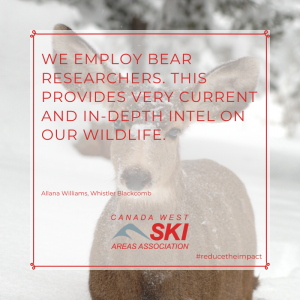Reduce the impact: respecting wildlife
As stewards of the land, Canada West Ski Areas Association (CWSAA) members take a serious responsibility to protect the biodiversity in each area, minimizing pollution and reducing their impact on the land, wildlife, air and water. Throughout the winter, we are highlighting leading examples from various resorts and the steps they are taking to reduce their impact on the environment.
Wildlife may be less noticeable in the winter months compared to summer as animals hibernate or move to lower elevations, but it remains a ski area priority to protect the biodiversity of each area and reduce any impact, especially on wildlife.
At Whistler Blackcomb, wildlife values are considered with all trail development. The development, along with restoration practices, are designed to include enhancement of black bears and coastal mountain black-tailed deer habitat.
“Whistler Blackcomb employs bear researchers,” explains Allana Williams, Regional Sustainability Manager at Whistler. “This provides very current and in-depth intel on our wildlife.”
 Ski areas also partner with agencies like Parks Canada. Marmot Basin in Jasper and The Lake Louise Ski Area west of Banff spend a significant amount of time monitoring wildlife activities and movement patterns. Lake Louise utilizes 38 wildlife cameras for this purpose.
Ski areas also partner with agencies like Parks Canada. Marmot Basin in Jasper and The Lake Louise Ski Area west of Banff spend a significant amount of time monitoring wildlife activities and movement patterns. Lake Louise utilizes 38 wildlife cameras for this purpose.
Numerous ski areas incorporate wildlife education into their programming. Mount Seymour offers summer youth camps that teach children about respecting the living world around them – both in terms of wildlife and plant life. Big White and other ski areas with summer operations use educational signage to educate guests on the flora and fauna that are natural to the region so that users can respect and protect the habitat.
It’s partnerships like these that keep wildlife protection a top priority for ski areas and will for many years to come.
Find out more about Responsible Stewardship in the Ski Industry.

